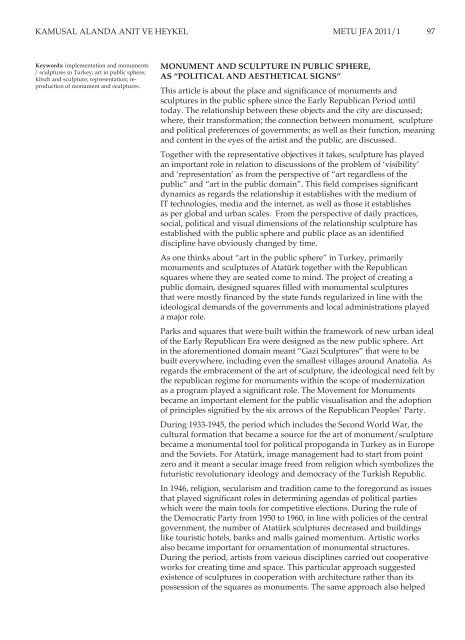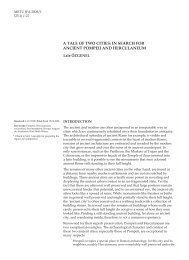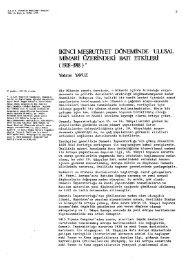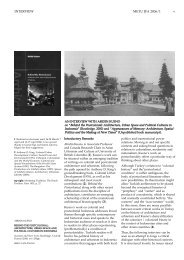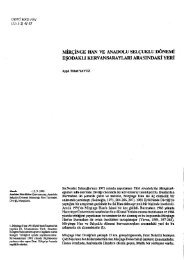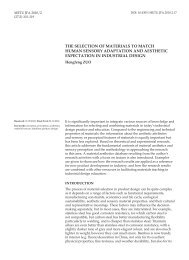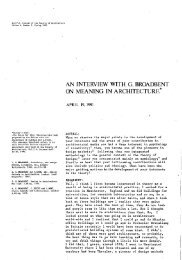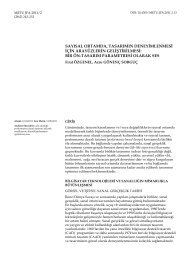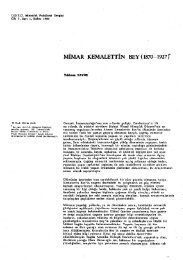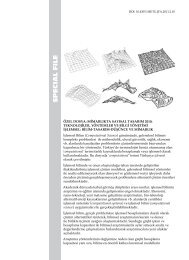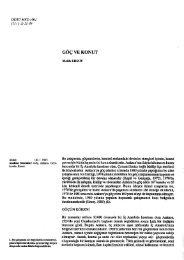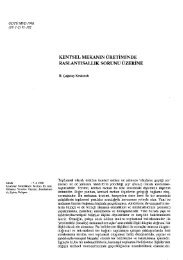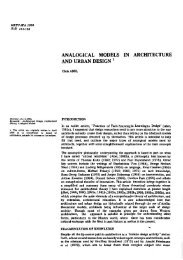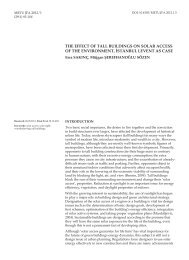siyasi/estetik gösterge - Journal of the Faculty of Architecture
siyasi/estetik gösterge - Journal of the Faculty of Architecture
siyasi/estetik gösterge - Journal of the Faculty of Architecture
Create successful ePaper yourself
Turn your PDF publications into a flip-book with our unique Google optimized e-Paper software.
KAMUSAL ALANDA ANIT VE HEYKEL METU JFA 2011/1 97<br />
Keywords: implementation and monuments<br />
/ sculptures in Turkey; art in public sphere;<br />
kitsch and sculpture; representation; reproduction<br />
<strong>of</strong> monument and sculptures.<br />
MONUMENT AND SCULPTURE IN PUBLIC SPHERE,<br />
AS “POLITICAL AND AESTHETICAL SIGNS”<br />
This article is about <strong>the</strong> place and significance <strong>of</strong> monuments and<br />
sculptures in <strong>the</strong> public sphere since <strong>the</strong> Early Republican Period until<br />
today. The relationship between <strong>the</strong>se objects and <strong>the</strong> city are discussed;<br />
where, <strong>the</strong>ir transformation; <strong>the</strong> connection between monument, sculpture<br />
and political preferences <strong>of</strong> governments; as well as <strong>the</strong>ir function, meaning<br />
and content in <strong>the</strong> eyes <strong>of</strong> <strong>the</strong> artist and <strong>the</strong> public, are discussed.<br />
Toge<strong>the</strong>r with <strong>the</strong> representative objectives it takes, sculpture has played<br />
an important role in relation to discussions <strong>of</strong> <strong>the</strong> problem <strong>of</strong> ‘visibility’<br />
and ‘representation’ as from <strong>the</strong> perspective <strong>of</strong> “art regardless <strong>of</strong> <strong>the</strong><br />
public” and “art in <strong>the</strong> public domain”. This field comprises significant<br />
dynamics as regards <strong>the</strong> relationship it establishes with <strong>the</strong> medium <strong>of</strong><br />
IT technologies, media and <strong>the</strong> internet, as well as those it establishes<br />
as per global and urban scales. From <strong>the</strong> perspective <strong>of</strong> daily practices,<br />
social, political and visual dimensions <strong>of</strong> <strong>the</strong> relationship sculpture has<br />
established with <strong>the</strong> public sphere and public place as an identified<br />
discipline have obviously changed by time.<br />
As one thinks about “art in <strong>the</strong> public sphere” in Turkey, primarily<br />
monuments and sculptures <strong>of</strong> Atatürk toge<strong>the</strong>r with <strong>the</strong> Republican<br />
squares where <strong>the</strong>y are seated come to mind. The project <strong>of</strong> creating a<br />
public domain, designed squares filled with monumental sculptures<br />
that were mostly financed by <strong>the</strong> state funds regularized in line with <strong>the</strong><br />
ideological demands <strong>of</strong> <strong>the</strong> governments and local administrations played<br />
a major role.<br />
Parks and squares that were built within <strong>the</strong> framework <strong>of</strong> new urban ideal<br />
<strong>of</strong> <strong>the</strong> Early Republican Era were designed as <strong>the</strong> new public sphere. Art<br />
in <strong>the</strong> aforementioned domain meant “Gazi Sculptures” that were to be<br />
built everywhere, including even <strong>the</strong> smallest villages around Anatolia. As<br />
regards <strong>the</strong> embracement <strong>of</strong> <strong>the</strong> art <strong>of</strong> sculpture, <strong>the</strong> ideological need felt by<br />
<strong>the</strong> republican regime for monuments within <strong>the</strong> scope <strong>of</strong> modernization<br />
as a program played a significant role. The Movement for Monuments<br />
became an important element for <strong>the</strong> public visualisation and <strong>the</strong> adoption<br />
<strong>of</strong> principles signified by <strong>the</strong> six arrows <strong>of</strong> <strong>the</strong> Republican Peoples’ Party.<br />
During 1933-1945, <strong>the</strong> period which includes <strong>the</strong> Second World War, <strong>the</strong><br />
cultural formation that became a source for <strong>the</strong> art <strong>of</strong> monument/sculpture<br />
became a monumental tool for political propoganda in Turkey as in Europe<br />
and <strong>the</strong> Soviets. For Atatürk, image management had to start from point<br />
zero and it meant a secular image freed from religion which symbolizes <strong>the</strong><br />
futuristic revolutionary ideology and democracy <strong>of</strong> <strong>the</strong> Turkish Republic.<br />
In 1946, religion, secularism and tradition came to <strong>the</strong> foregorund as issues<br />
that played significant roles in determining agendas <strong>of</strong> political parties<br />
which were <strong>the</strong> main tools for competitive elections. During <strong>the</strong> rule <strong>of</strong><br />
<strong>the</strong> Democratic Party from 1950 to 1960, in line with policies <strong>of</strong> <strong>the</strong> central<br />
government, <strong>the</strong> number <strong>of</strong> Atatürk sculptures decreased and buildings<br />
like touristic hotels, banks and malls gained momentum. Artistic works<br />
also became important for ornamentation <strong>of</strong> monumental structures.<br />
During <strong>the</strong> period, artists from various disciplines carried out cooperative<br />
works for creating time and space. This particular approach suggested<br />
existence <strong>of</strong> sculptures in cooperation with architecture ra<strong>the</strong>r than its<br />
possession <strong>of</strong> <strong>the</strong> squares as monuments. The same approach also helped


